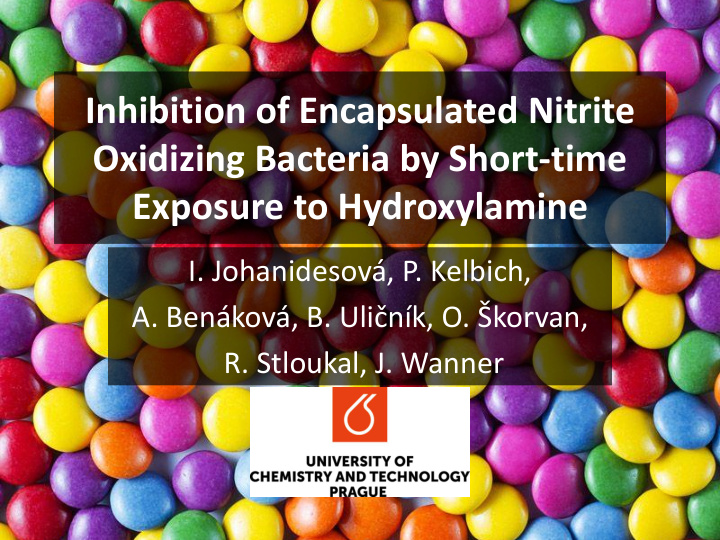



Inhibition of Encapsulated Nitrite Oxidizing Bacteria by Short-time Exposure to Hydroxylamine I. Johanidesová , P. Kelbich, A. Benáková , B. Uličník , O. Škorvan , R. Stloukal, J. Wanner
Introduction • Nitrification – Nitritation • AOB – Nitration • NOB • Partial nitrification – Oxygen demand 25% lower – Decreased COD consumption
Introduction • Nitration inhibition – Higher concentration of nitrification substrates, products and intermediates – Hydroxylamine • Suspended biomass: 0.42 mg/l N-NH 2 OH • Biofilters: 2.5 – 5.0 mg/l N-NH 2 OH
Introduction • Immobilisation – Supports slowly growing MO – Encapsulation in PVA or PEG • Protection againts external conditions • Lower sensitivity on inhibitors presence, pH value or temperature changes
Materials and methods • LentiKat ’s
Materials and methods
Materials and methods I (dose) • SBR • 50 g pellets – Nitrosomonas europaea , Nitrobacter winogradskyi • 1 l diluted rejected water • HRT 3.3 days • DO > 4 mg/l, pH 7.0 – 7.3 • Initial N-NH 2 OH concentration 10 – 200 mg/l
Results I (dose) • N-NH 2 OH 0 mg/l (left) and 50 mg/l (right)
Materials and methods II (HRT) • SBR • 100 g pellets – Nitrosomonas europaea , Nitrobacter winogradskyi • 1.2 l diluted rejected water • N amon loading 200 mg/(l.d) • DO > 4 mg/l, pH 7.2 ± 0.15 • Initial N-NH 2 OH concentration 200 mg/l • HRT 1 day and 3 days
Results II (HRT) • 1-day HRT – c(N-NO 2 ) MAX = 150 mg/l • 3-days HRT – c(N-NO 2 ) MAX = 500 mg/l
Results (FISH) • AOB before (left) and after (right) inhibition
Conclusion • Because of higher chemical resistance of bacteria which are immobilised in PVA pellets the N-NH 2 OH concentration needed is higher than in the case of suspended biomass. • Unfortunately, the N-NH 2 OH concentration needed for full nitration inhibition has not been found. • However, partial nitrification with immobilised biomass using nitration inhibition with hydroxylamine could be an appropriate method for nitrogen removal from water with high N amon concentration.
Acknowlogements • Financial support from – specific university research (MSMT No 20- SVV/2016) – Ministry of industry and trade of the Czech Republic (project FR -TI4/254) – foundation „Nadání Josefa, Marie a Zdeňky Hlávkových“
Recommend
More recommend